When planning a circuit polypropylene piping a situation often arises when it is necessary to join pipes of different diameters or even from different materials. In this case, the polypropylene adapter sleeve is able to simplify the solution of the problem. It will be possible to carry out the work in the least costly way. But how to do this and what nuances should you know?
The content of the article:
-
Where is used
- Entering an apartment or house
- Heating systems
- In what conditions can it be operated
- How to choose reducer couplings
-
How is the coupling installed
- Problems with soldering the adapter sleeve
Where is used
The polypropylene transition sleeve is a universal additional element that is used in almost any pipelines made of PPR brazed polypropylene. Outwardly, it looks like a round plastic cup with thick walls without a bottom. This shape guarantees the fitting a strong and secure connection.
Reducing couplings for polypropylene pipes are used for:
- one-piece soldered connection of two PPR pipes;
- transition from a polypropylene pipe to a steel or metal-plastic one.
A nondescript-looking part is a versatile tool that can help solve small but important water or heating problems.
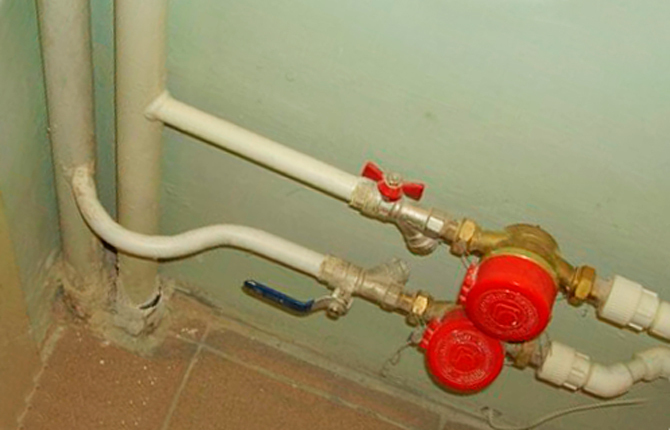
Entering an apartment or house
The most popular option is the transition from a large diameter to a smaller pipe size. Typically, the plumbing pipe in the wells of apartment buildings is made with a polypropylene pipe of at least 2 ”. The layout of the apartment is made up to 3/4 ”. Therefore, at the outlet of the water pipe, it is necessary to install an adapter sleeve with an external thread to connect a water meter.
For domestic water supply, a transitional polypropylene sleeve is used:
- for joining polypropylene pipes and steel pipes;
- in places where any metal fittings are inserted - from brass taps to mud filters;
- at the entrance to the house, a polyethylene food line is usually laid along the site, then an adapter from polyethylene to metal. The last is the transition polypropylene coupling for soldering;
- in caisson blocks of wells for connecting a water supply to an expansion tank or pumping equipment.
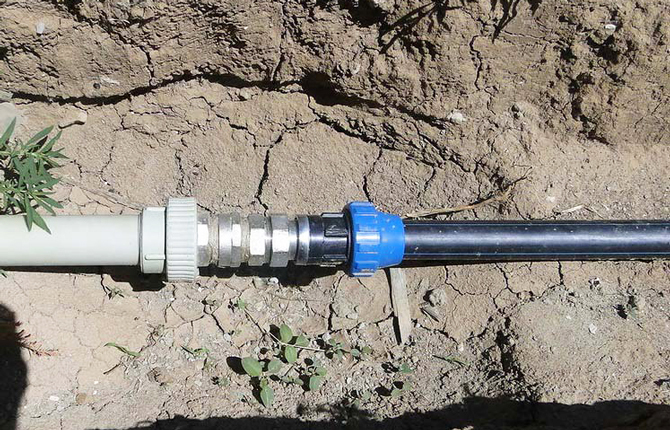
A transitional fitting-coupling is often placed on the end of a blind section of a water supply system. In this case, a polypropylene transition sleeve with an external thread is used. A flexible pipe is screwed onto the threaded section for supplying water to a gas water heater, a double-circuit boiler or a boiler.
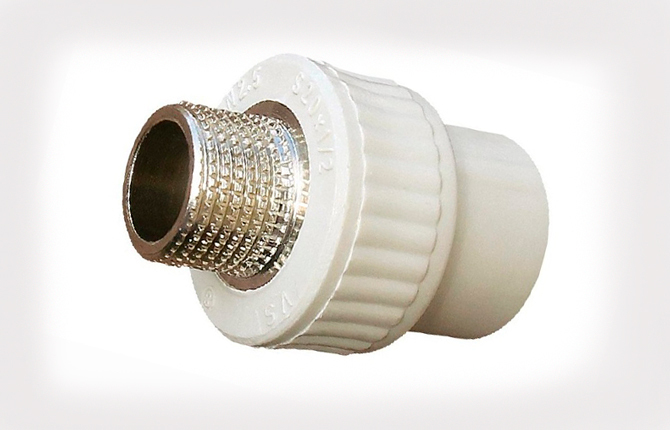
Heating systems
Polypropylene couplings are used in the heating circuit to connect a safety group, expansion tanks, and install pressure gauges. Pipes can be used from polypropylene, while all valves and control fittings are only made of brass or stainless steel.
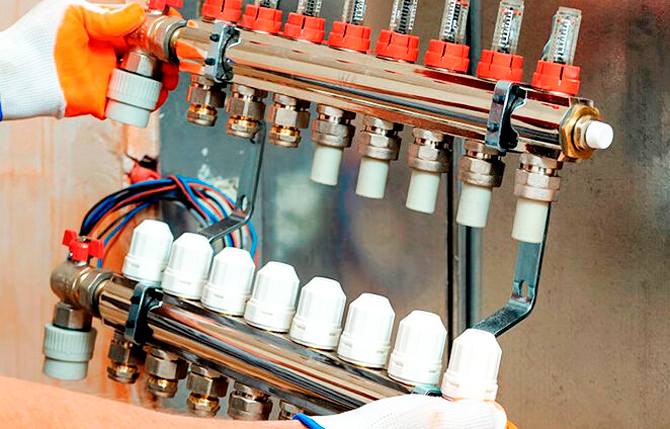
Heating radiators made of aluminum, bimetal or cast iron in heating systems are connected using transition couplings, but already with a union metal nut.
Fitting-couplings are placed on the distribution manifold if, in addition to radiators, the "warm floor" system is used in the house or apartment.
In addition to the classic straight fittings, angle models are widely used, which inlet and outlet have different diameters, and at the same time are deployed at an angle of 90 ゜ to each other. The outlet can be with a metal union for pipe threads.
In what conditions can it be operated
Reducing couplings for polypropylene pipes are capable of working in extreme conditions.
For example, in hot water, the material can withstand for a long time:
- working pressure up to 16 At;
- ambient temperature up to + 95 ℃.
Neither metal-reinforced plastic nor cross-linked polyethylene can compete with polypropylene lines. The sleeve connection is obtained with a cast, homogeneous structure, there are no joints, seals, seams through which hot water or steam could "escape".
Only polypropylene couplings with a special reinforcing additive in the form of chopped fiberglass can boast of high resistance to steam and hot water. For standard fittings, a temperature limit of 60 ℃ is set at a pressure of up to 20 At.
Due to the cast structure, the transition couplings are not afraid of mechanical stress. Reinforced-plastic and polyethylene PEX pipes have to be additionally fastened to the wall at the places where the crimp fittings are installed. This is done in order to compensate for the deflection and load at the joints, otherwise the sealing gaskets will quickly fail.
This is not required for polypropylene pipes assembled on hot-brazed transition couplings. Craftsmen put clamps and fasten polypropylene pipelines only to improve their appearance. The PPR pipe of hot water supply expands and sags slightly when heated. The strength and reliability of the adapter does not change from this.
The only drawback of using a reducing sleeve can be manifested in the transition from a large pipe diameter to a small one. If the fitting is welded with a slight overheating, and the parts were connected with excessive force, then an annular seam is formed inside the polypropylene sleeve. It practically does not affect the throughput, but due to the acceleration of the flow of water in a pipe of a smaller diameter, it can cause sound vibrations.
Couplings for polypropylene pipes are not afraid of corrosion, even if you have to make a joint with a steel or metal-plastic pipe. There are no substances in the composition of polypropylene that provoke the formation of rust or oxidation of aluminum, therefore, there are no problems with the compatibility of the polypropylene and metal parts.
How to choose reducer couplings
It is necessary to choose the correct design of the polypropylene fitting. The transition system assumes that pipes of different diameters will be joined in the welded joint. The more the cross-sections at the inlet and outlet differ, the stronger the turbulence of the water flow and the higher the hydraulic losses.
| Name | Smallest diameter, mm | Largest diameter, mm | Coupling length, mm |
| Transition 50-63-66 | 50 | 63 | 66 |
| Transition 32-40-44 | 32 | 40 | 44 |
| Transition 25-32-44 | 25 | 32 | 44 |
| Transition 40-50-54 | 40 | 50 | 54 |
| Crossing 50-75-72 | 50 | 75 | 72 |
| Transition 25-40-49 | 25 | 40 | 49 |
| Transition 40-63-64 | 40 | 63 | 64 |
| Transition 32-50-51 | 32 | 50 | 51 |
| Transition 63-75-71 | 63 | 75 | 71 |
| Crossing 20-25-37 | 20 | 25 | 37 |
The resistance increases in proportion to the difference in diameter:
- if the difference is ½ ”, the losses increase by 25%;
- by ¾ "- the pressure is lost by 35-40%.
The given data apply only to those lines where the flow velocity in the pipe is more than 3 m / s. For a polypropylene pipe with a cross-section of ¾ ", this corresponds to a water flow rate for the spout in the range of 0.7-1.0 l / s. In other cases, the hydraulic loss of resistance in the transition section can be ignored.
If the difference in diameters is large, several intermediate couplings can be installed at a flow rate of more than 3 l / s. The only nuisance may be the accumulation of sediment and rust at the junction of two polypropylene pipes.
It is necessary to take into account the nature of the transition. If a transition fitting with an external threaded outlet is installed, then the model with a short threaded section will be more preferable for hot water. For pressures over 10 Atm, we use an extended fitting. In this case, a transition sleeve and a clamping nut are placed on the thread.
Another nuance is the quality of the fittings themselves. BOREALIS couplings are considered the best solution in terms of price and quality, although Czech or Turkish reducing couplings can be used with equal success.
How is the coupling installed
Half of the problems with PPR pipes arise from poor-quality installation couplings.
The process itself looks simple:
- we cut the pipe blank using cutting shears. Cutting with another tool is not recommended;
- we remove the chamfer on the edge along the end;
- we install nozzles on the soldering iron according to the size of the pipe and the corresponding section of the adapter;
- heat up and quickly, but without haste, insert the workpiece into the fitting. We sit down with little effort.
After about 5-7 minutes, the weld point cools down completely.
As accurately as possible, observe the heating time of polypropylene blanks on the soldering iron nozzles. Experienced craftsmen determine the degree of heating from their own experience, and it is better for novice workers to use the table.
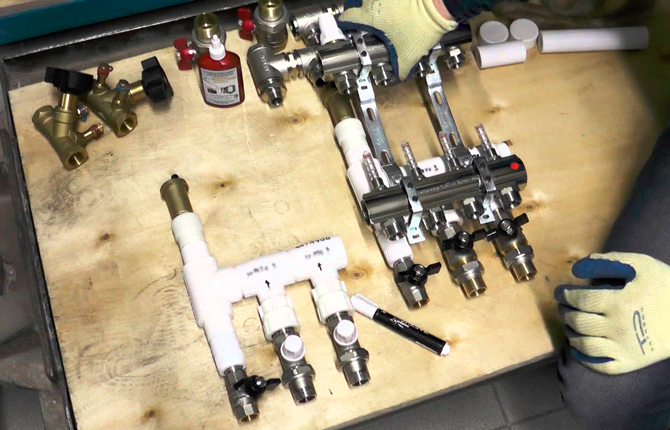
Problems with soldering the adapter sleeve
Most often, welding is performed either overheated, and then an annular bead is formed inside the workpiece, or subcooled, in which case the seam may be weak. If there is no practical experience, then you can practice on polypropylene scraps.
Usually, the transition outlet is soldered first, the one with the smaller diameter. This makes it easier to make a more complex weld joint on a pipe with a larger diameter. It is necessary to try to put on the coupling exactly along the axis, avoiding deviation from the alignment. Otherwise, the weld seam or burr will turn out to be of different thickness, which means that unsoldered areas may remain.
Another nuance is associated with the installation of corner fittings with an external thread. The first is to solder the joint from the side of the polypropylene pipe. Pre-align the position of the transition bend relative to the steel section.
The metal fitting is wrapped with a damp cloth and welded onto the polypropylene part. In this form, you need to leave the fitting until it cools completely, do not try to try on the squeegee or screw on the coupling or nut. Any inaccurate handling of the hot fitting can cause the polypropylene to peel off inside the housing.
Have you had any problems when soldering pipes and fittings?
Yes, I figured it out quickly.
0%
No, everything went smoothly.
100%
I do not solder pipes myself.
0%
Voted: 1
The polypropylene transition sleeve is durable and strong. Thanks to the thickened, massive walls, the joint is durable if the selection and installation of the fitting was carried out with a high-quality tool using proven technology.
Welding of polypropylene pipes of different diameters and types through a transition sleeve: video.
Share your experience with transition fittings in the comments. What problems did you encounter? How did you manage to solve them? Bookmark the article so that you can return to useful information at any time. Share the fuck on social networks.


